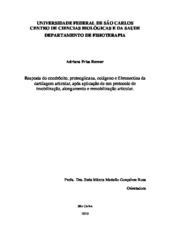Resposta do condrócito, proteoglicana, colágeno e fibronectina da cartilagem articular, após aplicação de um protocolo de imobilização, alongamento e remobilização articular
Abstract
The function of articular cartilage depends on the chondrocytes and on the components of the extracellular matrix, which in turn may be regulated by mechanical stimuli. Thus, changes in load support may affect its composition or its structure and interfere with their functional ability to sustain and distribute loads and minimize the stresses of contact. Thus, investigations of articular cartilage components, such as chondrocyte and or matrix components are essential for prevention and treatment of arthritic disease. A greater understanding of the relationship of use / disuse and degeneration as well as the consequences of situations such as shear stress, static load or unloading can generate in this tissue. The aim of this study was to evaluate the response of chondrocytes, proteoglycan, collagen and fibronectin in articular cartilage after application of a protocol of immobilization, stretching and joint remobilization. Material and Methods: We used 36 animals divided into six groups (n = 6): immobilized (I), immobilized and stretched seven days per week (IS7), immobilized and stretched three days per week (IS3), stretched seven days per week (S7), stretched three days per week (S3) and control (C). Groups I, IS3 and AS7 underwent four weeks of immobilization of the left hind limbs. Groups IS7 and IS3, after immobilization, were subjected to three weeks of the posterior muscle stretching of the left hind leg daily or three times per week, respectively. The S3 and S7 groups remained free in the cage for 4 weeks and subsequently underwent three weeks of posterior muscle stretching of the left hind limb daily or three times per week, respectively. After these procedures, the left ankle were collected, decalcified, processed in paraffin and stained with H&E, Safranin-O, Picrossiruius Red and immunostained with fibronectin and chondroitin sulfate 4 for further analysis. Two observers evaluated parameters such as chondrocyte cloning, loss of proteoglycan content, thin and thick fibrils collagen content, intensity of staining for fibronectin and chondroitin sulfate 4. For statistical analysis we used the following tests: Kruskal Wallis and post hoc Newman Keuls: cloning and the proteoglycan content of the different groups); Duncan multiple comparison: morphometric evaluation of cellularity; ANOVA and post hoc Tukey: proportion of thin and thick fibrils of collagen. For analysis of the immunohistochemistry reactions of fibronectin and chondroitin sulfate 4 it was used nonparametric test Kruscal Wallis and post hoc Newman Keuls. In all tests the significance level was p ≤ 0.05. Results: With respect to the cellularity IS7 group showed significant increase in cellularity compared to groups I and C. The IS3 group also showed significant celullar change with the formation of chondrocyte cloning compared to groups S7, S3 and C. The most significant loss of proteoglycan was in IS7 group compared to all other groups. The I group also lost significantly more proteoglycan than the others, except for IS7 group. With respect to collagen fibrils was observed that immobilization (I) significantly reduced the thin fibrils in relation to groups IS3, S7, S3 and C. The quantity of thick fibrils was influenced by mechanical overload, as there was a significant decrease of it in all groups compared to control. With respect to the findings of the fibronectin, the groups immobilized and stretched (IS3 and IS7) had significantly higher intensity staining of fibronectin than other groups. There was no statistical difference of chondroitin sulfate 4 immunostaining among the different groups. Conclusion: The protocols of muscle stretching after immobilization, applied on alternate days and daily provoked distinct adaptive responses in articular cartilage. The immobilization stimulated tissue atrophy that when stimulated by muscle stretching on alternate days, kept some matrix components, such as fine fibrils of collagen and proteoglycan, unlike the protocol used daily. Thus we can conclude that muscle stretching applied in previously immobilized joints should be applied with caution, on alternate days of mechanical stimulation.
Collections
Related items
Showing items related by title, author, creator and subject.
-
Análise da expressão sistêmica de biomarcadores de degradação articular: um comparativo entre atletas profissionais de futebol com e sem histórico de lesões articulares em membro inferiores
Zacharias, André Luís Simões (Universidade Federal de São Carlos, UFSCar, Programa de Pós-Graduação em Fisioterapia - PPGFt, Câmpus São Carlos, 30/09/2021)Professional soccer participation exposes players to the highest frequencies and intensities of loads and joint injuries in the lower limbs. These factors are associated with greater risks of osteoarthritis development. ... -
O Efeito de um protocolo de alongamento muscular passivo sobre a cartilagem articular.
Renner, Adriana Frias (Universidade Federal de São Carlos, UFSCar, Programa de Pós-Graduação em Fisioterapia - PPGFt, , 25/02/2005)Objective: The aim of this study is to evaluate the articular cartilage alterations of rat ankles, after applying unilateral cyclic passive muscle stretching protocol for three weeks in previously immobilized rats. Materials ... -
Hipermobilidade e dor no punho em ginastas jovens: perfil descritivo, análise de associação e relevância clínica
Marolde, Isabela Bianchini (Universidade Federal de São Carlos, UFSCar, Programa de Pós-Graduação em Fisioterapia - PPGFt, Câmpus São Carlos, 25/02/2021)Introduction: Flexibility is an important factor for gymnasts to perform their maneuvers and elements. A greater than normal range of motion in most of the joints is called general joint hypermobility. There is a higher ...
